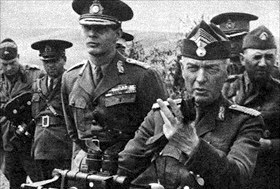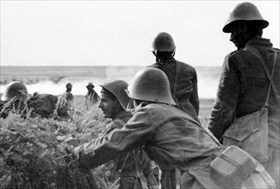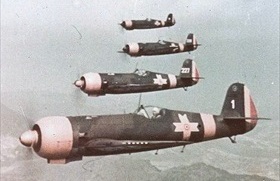ROMANIA JOINS AXIS MILITARY PACT
Bucharest, Romania · November 23, 1940
In September 1940 Field Marshal Wilhelm Keitel, chief of the German high command, announced that Wehrmacht troops were being sent to Romania “in case a war with Soviet Russia is forced upon us.” Early the next month German troops entered the country ostensibly to train and rebuild the Romanian military after King Carol II abdicated in favor of his 19‑year‑old son Michael (Mihai). Actually the German presence protected Romania’s dozen oil fields in and around Ploesti (Ploieşti), which had become vitally important to the German war effort since Germany itself possessed virtually no oil outside synthetic oil laboriously extracted from the nation’s plentiful coal deposits. On this date in 1940 Romanian dictator Marshal Ion Antonescu followed neighboring Hungary into the Axis Tripartite military pact. The pact, signed at its outset by representatives of Germany, Italy, and Japan on September 27, 1940, in Berlin, pledged member states to fight any state that declared war on another treaty member. Antonescu’s decision to throw his country’s lot in with other Axis states—Slovakia, a puppet state from dismembered Czechoslovakia, joined the next day—had devastating and long-term consequences for his country when Romania became Adolf Hitler’s principal spear carrier in Eastern Europe. (Romanians sent to fight in the Soviet Union exceeded the number of all of Germany’s other allies combined, including Italy.) In the fighting around Stalingrad (Volgograd) alone (November 1942 to the end of January 1943), Romanian Third and Fourth Army dead, wounded, and missing approached 160,000 men (one source says 200,000), with heavy losses in artillery, armor, and aircraft. Some 3,000 Romanians entered Soviet captivity. The staggering losses effectively ended Romania’s offensive capability for the remainder of the war and pushed the country into exploring ways to withdraw from the conflict. In the fall of 1944, with the U.S. Army Air Forces hammering Romania from above, a resurgent Soviet Union overran Romania, forcing an armistice. Romania’s defection significantly hastened the end of the war. Her natural resources were now denied to Germany and her forces constituted the fourth largest Allied army. Of the 538,000 Romanian soldiers who fought the Axis in 1944–45 (in Hungary, Yugoslavia, Austria, and Czechoslovakia), some 167,000 were killed, wounded, or went missing.
[amazon_carousel widget_type=”ASINList” width=”600″ height=”200″ title=”Recommended Reading” market_place=”US” shuffle_products=”False” show_border=”False” asin=”1891227564,0140284583,0752490109,1935149393,0582771854,1855321696,1300136618,1594160775,1846030285,1403993416″ /]
Romanian Armed Forces During World War II
 |  |
Left: As a member of the Axis, Romania joined the invasion of the Soviet Union on June 22, 1941 (Operation Barbarossa). Romanian forces played a large role during the fighting in Bessarabia, which the Soviets occupied in 1940 in the wake of the 1939 Molotov-Ribbentrop Pact, as well as in the Ukraine, Crimea, and Stalingrad. In this photograph King Mihai I (left) and Gen. Ion Antonescu are seen inspecting the Bessarabia front in July 1941. Romanian troops suffered heavy casualties retaking Bessarabia: 22,765 men and 58 aircraft. Soviet losses were 17,893. On August 21, 1941, as a reward for commanding the troops that returned Bessarabia and Northern Bukovina to Romania, Mihai confirmed the rank of Field Marshal on Antonescu.
![]()
Right: Romanian troops in the Don-Stalingrad area, mid-1942. The Romanians reached the Don River on July 27, where they began assisting German troops. In early August the two armies had broken through Soviet defenses. In September the Third and Fourth Romanian Armies took up positions around Stalingrad, as did the German Sixth Army, the German Fourth Panzer Army, the Italian Eight Army, and the Hungarian Second Army. At the same time the first elements of the Romanian Air Corps arrived on the Stalingrad front.
_w_Soviet_POWsA_280x181.jpg) |  |
Left: Romanian forces took part in the Axis Crimean campaign of 1942. This photograph depicts Romanian soldiers with Soviet POWs during a rest period. The fighting around the strategically important Soviet naval base at Sevastopol continued until July 4, 1942, when the campaign ended. The Red Army suffered 50,000–60,000 casualties and the loss of about 95,000 taken captive defending the city. Axis armies lost 35,559 men, of which 8,454 were Romanian, during the same battle. The total number of casualties suffered by Romanian troops during the 295 days of the Crimean campaign was about 19,000.
![]()
Right: The IAR 80 was the main Romanian fighter during World War II, remaining in front-line use until the 1944 armistice. Some 346 units were produced up to September 30, 1944. When the IAR 80 entered service in 1939, it was comparable to the German Messerschmitt Bf 109E, the British Hawker Hurricane, and the U.S. Curtiss P‑40 Warhawk. In the summer of 1943, IAR 80s were transferred to Romania for air defense duties, where they were used in combat against low-flying, four-engine U.S. B‑24 Liberator attacks on the oil refinery installation at Ploieşti. According to Romanian statistics, on August 1, 1943, IARs and Messerschmitts shot down ten B‑24s, with two probables. On June 10, 1944, IAR 80s and German-piloted Messerschmitts took part in one of the major air battles over Romania when 36 U.S. P‑38 Lightning dive bombers, carrying one bomb each, attacked Ploieşti. The U.S. lost nearly two dozen P‑38s to the Axis two.
Photo Montage of Romanian Armed Forces on the Eastern Front, 1941–1943
![]()

 History buffs, there is good news! The Daily Chronicles of World War II is now available as an ebook for $4.99 on Amazon.com. Containing a year’s worth of dated entries from this website, the ebook brings the story of this tumultuous era to life in a compelling, authoritative, and succinct manner. Featuring inventive navigation aids, the ebook enables readers to instantly move forward or backward by month and date to different dated entries. Simple and elegant! Click
History buffs, there is good news! The Daily Chronicles of World War II is now available as an ebook for $4.99 on Amazon.com. Containing a year’s worth of dated entries from this website, the ebook brings the story of this tumultuous era to life in a compelling, authoritative, and succinct manner. Featuring inventive navigation aids, the ebook enables readers to instantly move forward or backward by month and date to different dated entries. Simple and elegant! Click 











